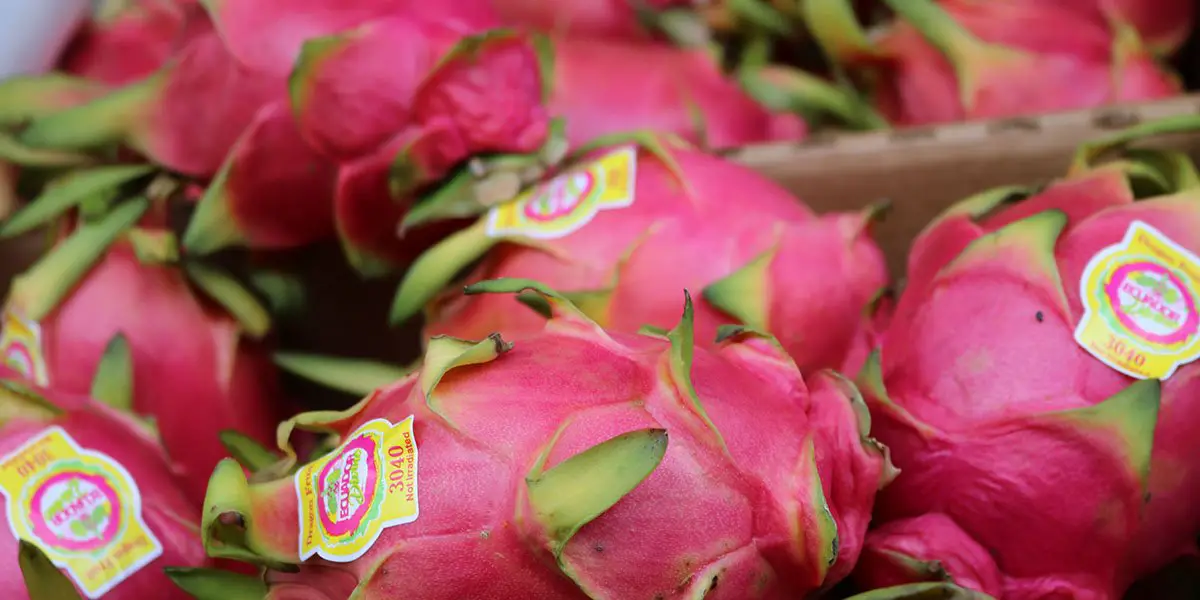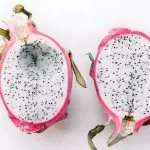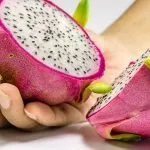Dragon fruit (or pitaya) is a relatively expensive tropical fruit. The cost of a single dragon fruit will differ depending on where and when you buy them, and it will also matter which variety you want.
In the USA, a fresh white dragon fruit costs $5.98 USD at Walmart. However, the price of a single dragon fruit can go as high as $15 USD each, depending on variety, size, ripeness, and country of origin.
Generally, frozen dragon fruit is the cheapest, costing only $9.99 USD at Costco for 3 pieces. Frozen pitayas are sold as cut cubes, limiting their usefulness. Storing dragon fruit in the freezer impacts the consistency of the flesh. It’s still great for use in baby food, desserts, smoothies, or juices.
Why Is Dragon Fruit So Expensive?
According to the Agricultural Marketing Resource Center, the main reason dragon fruit is so expensive is the fact that demand for dragon fruits is higher than the supply. The ‘superfood status’ of the exotic fruit has caused domestic demand to soar in the last few years.
The online magazine Mashed explained that $10 USD for a single organic pitaya would still be worth it for a lot of people, because of the many health benefits the fruit could provide.
With many people trying to live more consciously and incorporate a healthy lifestyle, this does make a lot of sense. The expensive price tag of the dragon fruit is likely the result of higher demand caused by its many potential health benefits.
Dragon Fruit Cost: How Is It Determined?
The price of dragon fruit is mainly determined by seasonality, size, ripeness, color, and country of origin. Organic dragon fruit will cost more to grow and label, making these varieties more expensive.
Keep in mind that the more flavorful red and yellow dragon fruit varieties will generally be more expensive. They are also a lot harder to find, especially as a fresh whole fruit.
Seasonality
White and red dragon fruit varieties are in season from June to September. Yellow dragon fruit is actually a winter fruit, harvested from November to February.
Much like other seasonal fruits, prices fluctuate based on availability. Right after harvesting, a lot of producers will offer their products on the open market, driving down average prices.
This means you’ll find the cheapest dragon fruits towards the end of the summer, roughly in the months of August and September. For the yellow variety, this would be the months of January and February.
Size
Dragon fruits are usually sold by piece, or in batches. However, the cost of the pieces is usually calculated in kilograms. Simply put, this means that bigger pitayas are more expensive.
Since bigger fruits give you more edible flesh, this price differentiation based on weight makes a lot of sense. Just make sure to check how big your pitayas are when you get them from the store. There’s usually an option to weigh them in the grocery aisle.
Ripeness
Unripe dragon fruits are cheaper than ripe and ready-to-eat ones. After all, time is money. Prolonged storage will make it more costly to eventually sell the fresh produce to consumers. If you’re on the market for a beautiful pink-colored delicacy, you’ll have to pay up.
Unripe green dragon fruits have a shorter turnover and require less lengthy storage, making it easier to sell them for less money. That’s capitalism for you.
On the other hand, an unsold overripe fruit is more likely to be discounted. It’s better to sell unsold produce for less, than to have to throw it away. So maybe you’ll be able to spot some ready-to-eat bargains in the supermarket (especially at the end of summer).
Color
Brown blotches on the skin and other inconsistencies can lower the value of dragon fruit. Supermarkets try to sell produce of the highest standards, and having A+++ quality means that the cost will also be higher.
Discount or wholesale supermarkets such as Walmart, LIDL, ALDI, or Costco sometimes settle for A+ quality colors instead, allowing their products to be slightly cheaper than the competition.
Country Of Origin
Tropical fruits in the supermarket aren’t always produced in the same region. In fact, it might change day-by-day where your dragon fruits are coming from. The country of origin for that day would be where the chain could buy the cheapest fruits.
One can imagine that transportation costs impact the price of an exotic product. Especially for fresh produce, costs can fluctuate based on a lot of factors, ranging from local weather to local disease risk. Even political factors and import tariffs will play a role in determining the price.
Where Can I Order Dragon Fruit Online?
Ordering fresh dragon fruit online is possible with stores such as Walmart and Amazon. You can also buy pitaya at specialty e-commerce stores for exotic and tropical fruits.
If you live in the United States, use the links below to purchase some dragon fruit for delivery:
- Walmart – A single fresh pitaya
- Amazon – Set of 6 fresh pitayas
- Instacart – Local fruit delivery in your area
- Full Moon Fruits – Select by size
- Tropical Fruit Box – All varieties
For people living in Canada, you can purchase from Walmart here. If you happen to live in the United Kingdom, you can purchase from Exotic Fruits here.
Choosing The Best Variety
If you’re not entirely sure which dragon fruit variety to choose, it’s recommendable to start with the sweeter options. These would be the yellow or red varieties, of which the yellow-skinned fruit is the sweetest choice.
While these might be a little difficult to find on the internet for local delivery, it should be easier to find some in a local specialty store. That could either be a major supermarket chain or a fresh produce store in your area.
The more common white variety is considered a bit bland in flavor by most people, even though it has the same possible benefits as the other ones. If you’re going for the best flavor experience, definitely give those red and yellow ones a try. You won’t regret it!



